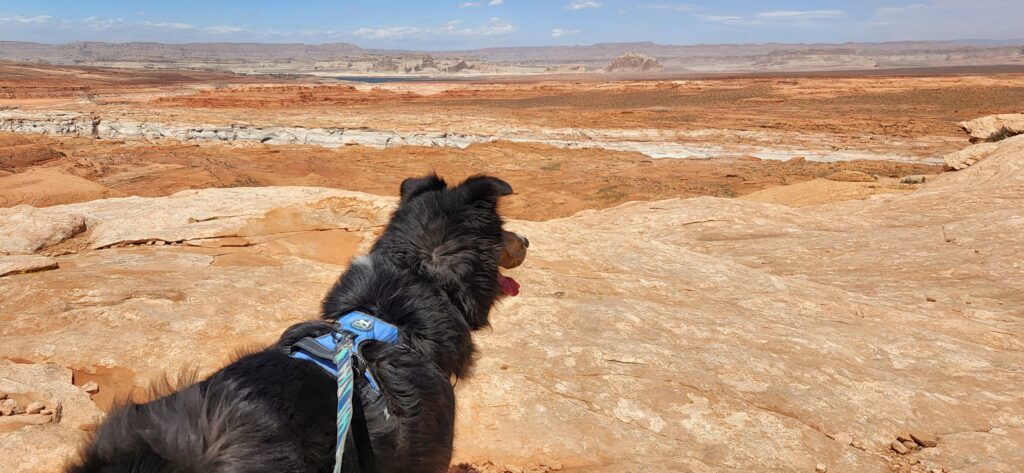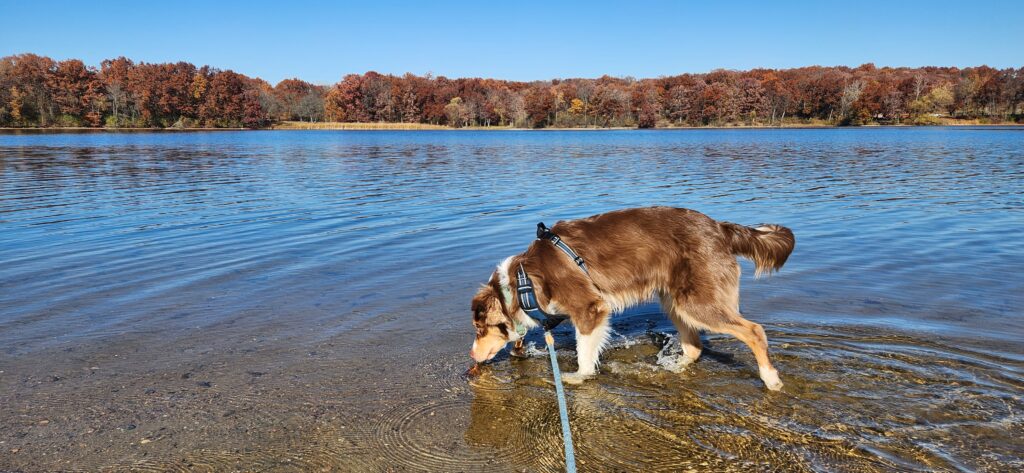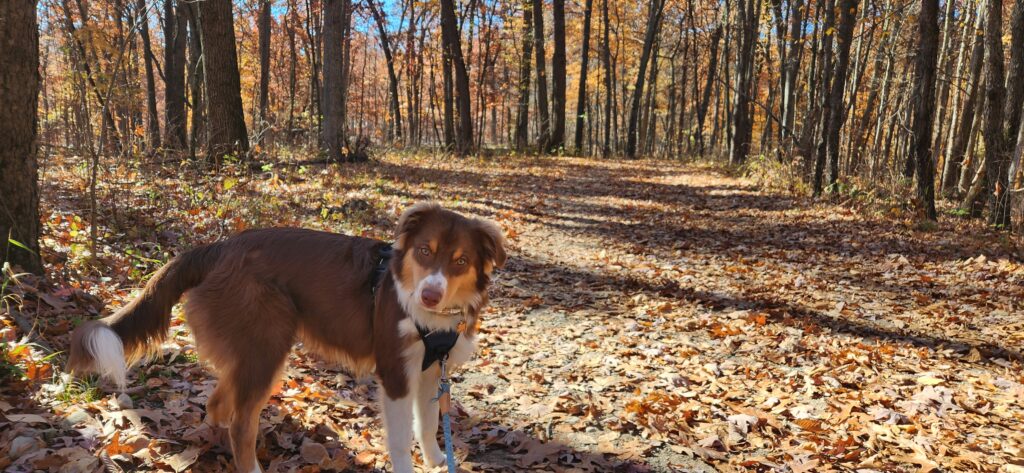
This post outlines my top tips for hiking with dogs for a fun and stress-free trip. I love hiking and recently I’ve been taking more excursions on my own. Instead of leaving the dog at home, I bring him along for the adventure!
With so many exciting, thrill-seeker outdoor activities being popularized these days, sometimes I feel a little boring when I say that hiking is my absolute favorite. It’s just so peaceful! Exploring a scenic patch of wilderness and getting around with only my own two feet feels therapeutic and humbling. I love taking it all in.
The smell of fresh air. The sound of songbirds. Views of rolling hills, stretches of untouched forest, or majestic rocky cliffs… Love it.
What makes the hiking experience even better? Bringing the dog along, of course.
Sharing the outdoor experience with your best buddy can help motivate you to hike longer, improve your sense of security and provide you both with some quality bonding time. What’s not to love about that!?
You’ll have to do some extra preparation and be a bit more diligent than you’d be without your dog. But hey – that can add to the advantages of bringing him along too, depending on how you look at it!
Tips for taking your dog hiking
Follow the tips below so you can have a great time hiking with dogs. This advice is most helpful if you’re taking your dog hiking for the first time, but can be a great refresher for anyone!
1. Ensure your dog is fit for hiking

You know your dog’s limits better than anyone else. Dogs with health conditions that may make it dangerous or painful to go for a hike should probably stay home.
If it’s been ages since your dog has even been on a walk, you may want to reconsider having them tag along on your next hike. You’re better off starting with some short walks around the neighborhood, then longer walks, then moving on to hikes.
If you’re unsure of your dog’s physical limits, consult your veterinarian. Even a perfectly healthy dog may not be fit for a long or challenging hike depending on the weather, terrain and your dog’s anatomy or coat (think stubby-nosed dogs or dogs with thick fur).
2. Get your dog up to date on vaccines and flea/tick medications
If you live in an area with fleas or ticks, it’s a good idea to get your dog current on their preventatives before trekking out into nature. Warding off fleas and ticks is both good for your dog’s health and well-being, but also reduces the chances of accidentally inviting a flea infestation into your home. EW.
A current rabies vaccine protects your dog in the unlikely event that he’s bitten by another animal.
3. Consider having your dog microchipped
Now is a great time to think about getting your dog microchipped, if you haven’t already. If your dog gets away during your hike, having a microchip improves the odds that he’ll find his way back to you. If microchipping is off the table, at least make sure your dog has a tag with your contact information on their collar. That’s the first thing someone will check if they find your dog.
4. Pack some dog hiking gear

When hiking with dogs, you should bring similar things for them as you would yourself. Think of things like:
- Lots of fresh water (+ water bowl)
- Food or snacks
- First aid kit
- Hiking shoes (optional)
- Poop bags (you probably don’t pack these for yourself, but hey, I wouldn’t judge)
Before you head out on your adventure, be sure their collar is secured comfortably and tight enough that they can’t slip out. While a collar is perfectly fine for a hike, I prefer using a harness. It gives me some extra control and my dog is more comfortable when he tugs (yes, when excitement gets the best of him, he can be a tugger).
And, of course, bring a leash. Many city and park ordinances throughout the US require dogs to be on a 6-foot leash. Unless you’ve done your research in advance that says otherwise, your best bet is to use a 6-foot or shorter lead.
Read More: 14 Must-Have Dog Essentials for the Perfect Road Trip
Out in nature, a shorter leash is a safer choice anyway since it gives you more control on the trails. Even if your dog is perfectly behaved, other people or dogs may not be, so keep your furry buddy close!
If you know you’ll be walking on rocky, sharp, or hot terrain, consider gearing your doggo up with some hiking shoes. Do they look ridiculous? Some may say so, but they’re quite practical depending on the condition of the ground your dog will be walking on. Shoes will keep your dog more comfortable on the trail and prevent injuries to the pads of their feet.
5. Check that the trails are dog-friendly

To avoid disappointment and hefty fines, check to make sure your hiking destination doesn’t have any pet restrictions.
Don’t be that person who brings a dog onto a trail where dogs aren’t allowed. It’s inconsiderate to your fellow hikers, could lead to a fine and could be unsafe for your dog.
When planning a hike in a US National Park, definitely don’t skip this step! Many of the National Parks don’t allow dogs off the parking lot, let alone on hiking trails.
6. Stay on the trail

For safety and to abide by park rules, staying on the marked hiking trails is a smart bet for everyone. If you’re not feeling it, let me try to convince you why:
- Staying on the marked trail reduces your chances of getting lost with your dog (your poor dog will want to go home eventually!).
- Staying out of nearby brush helps prevent stepping into problematic wildlife, like poison ivy or snakes.
- Sticking to the trail protects wild plants and animals that could otherwise be stepped on or put in danger by you or your dog.
- Many heavily trafficked trails or trails managed by US National Parks are regularly monitored and groomed. That said, the area around them may not be, so stepping off the path could put you and your dog on unstable terrain or expose you both to unsafe hiking conditions.
- Depending on where you’re hiking, leading a dog off the beaten path could earn you a fine.
When in doubt, stick to the path!
7. Be alert for wild animals

Depending on where you are hiking, the wildlife risks could range from running into a grumpy skunk to stumbling upon a curious bear. Before you head out, be sure to research the local wildlife you and your dog may meet and how to handle those encounters if they should happen.
If you’re hiking in bear country, always carry bear spray. Keep the can easily accessible as you hike, such as on your belt or backpack strap. Know how to use bear spray before you ever need to use it.
Again, it’s advisable to keep your dog on his leash or have an extremely reliable recall on your dog to keep them safe in the event of an animal encounter.
8. Adjust your routes for dog-friendly terrain
I don’t blame you if you want to hike to the top of every waterfall or interesting rock formation you see. I have the same tendencies that can be hard to control sometimes.
When you’re hiking with dogs, think twice about the routes and terrains you’re leading them through. Avoid slippery surfaces, sharp rock, excessively steep inclines, fast-flowing rivers, cliffs – you get the picture.
Save yourself the potential trauma and reserve your wild-child hiking thrills for an outing where your dog is left safely at home.
9. Check the weather

Some people are comfortable hiking in the rain or in extreme temperatures but be responsible and check the forecast before bringing your dog along with you. Some dogs are more prone to heat stroke, which could be disastrous on the trail.
In extreme heat, it’s not just the hot air you have to worry about, but also the ground. If you don’t plan on having Fido rock the doggy hiking shoes, check the ground temperature. Does holding your hand flat on the ground burn your hand? If so, it will burn your pup’s feet too.
Is it safe to take my dog hiking?
In general, yes! But keep special considerations in mind for puppies, older dogs and dogs with health conditions. You should also bear in mind the length and difficulty of your hike, along with the weather.
Puppies grow from tiny balls of fur into full-grown dogs in about a year. That’s A LOT of growing! During this phase, don’t overdo hikes or walks because they could cause developmental problems to their joints. Stick to walks or hikes of no more than a mile or about 20 minutes until they are older.
On the other hand, older dogs aren’t the youngsters they used to be. Even if they seem excited about a long hike, the heavy exercise of a long or difficult hike could leave them sore and uncomfortable for the next few days. If they’re in good enough shape to hike, bring them along, just don’t overdo it.
You may want to consider leaving dogs with health conditions that could make hiking unsafe at home. Talk to your vet before heading out on a hike.
If you’re taking your dog hiking for the first time, start with shorter, easier hikes and work your way up. Trails that have low elevation gain, no rock scrambles and are shorter than 3 miles would be a fantastic start! Check out AllTrails to choose suitable trails. They provide all kinds of stats and trail maps. You can even read other hikers’ reviews!
As mentioned before, even an easy trail may not be safe for your dog if the weather is too hot, icy or windy. Always check the weather before you go for a hike.
Read More: Bringing a Dog to a Hotel
Have fun!
Hiking with dogs can be a fantastic source of entertainment, exercise and bonding for you and your dog. If you’ve got an Energizer bunny dog I do, a nice hike is a good way to tire him out for the day (or at least a few hours)!
For me, having my favorite guy by my side makes enjoying nature even more fun. Plus, having him around gives me a sense of security too. He always notices things I don’t!
So, find yourself a dog-friendly destination, check the weather, pack your bag, be safe and have fun.
Now that you and your dog are ready to go, let’s hit the trails! Have a favorite dog-friendly hiking trail everyone should try? Please share in the comments and I’ll add it to my hiking bucket list!
Sincerely,






Leave a Reply